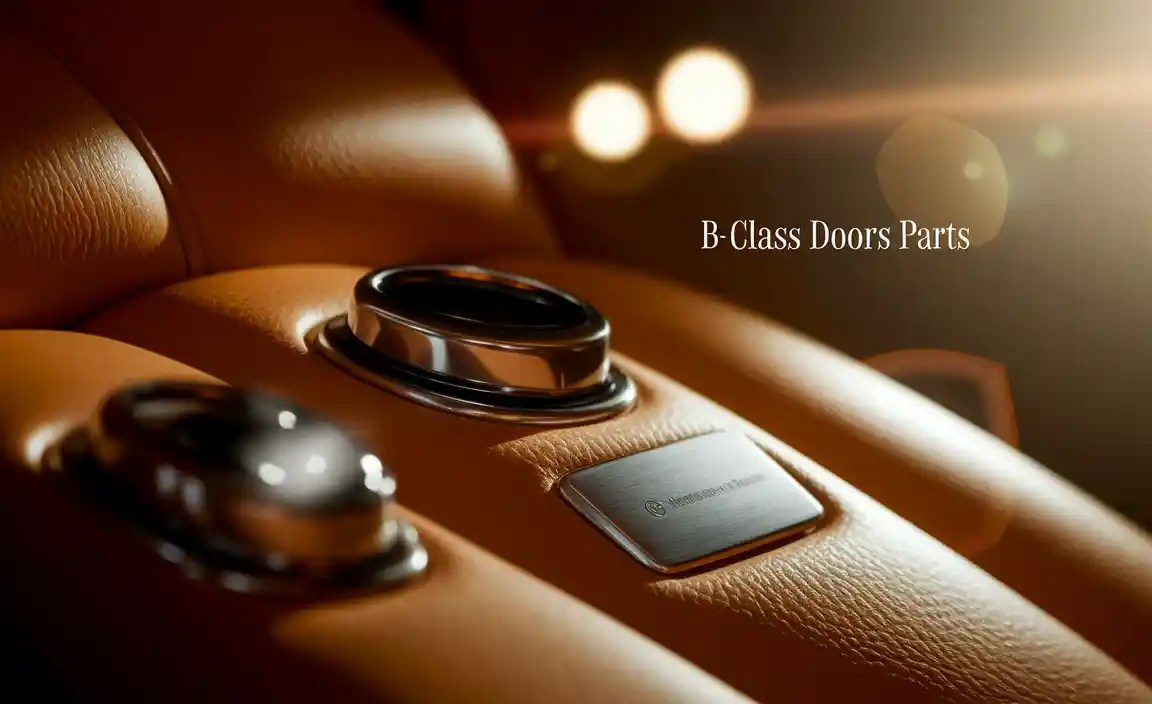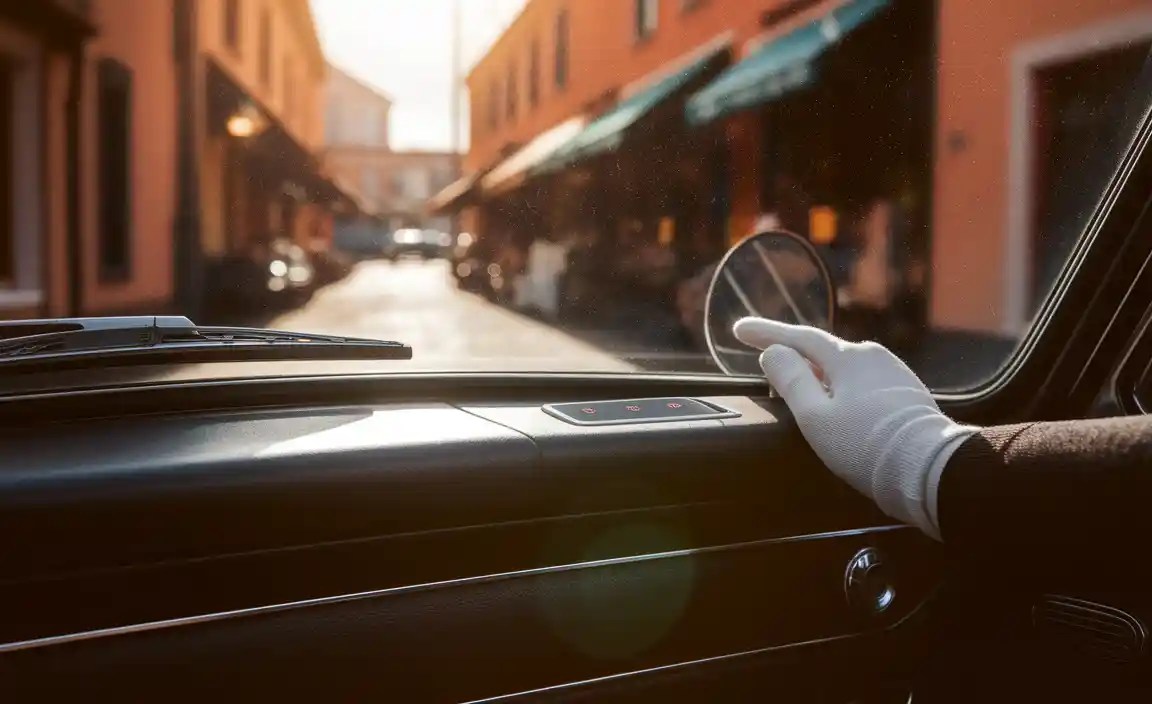B Class Doors Parts: Ultimate Performance
Explore essential B Class door parts and understand how they contribute to your Mercedes-Benz’s performance, safety, and luxurious operation. This guide reveals key components and their importance for optimal function.
Your Mercedes-Benz B-Class is a marvelous piece of engineering, designed for comfort, efficiency, and a touch of sportiness. While we often focus on the engine or suspension for performance, the doors play a surprisingly significant role. They aren’t just for getting in and out; they contribute to aerodynamics, safety, and the overall refined experience.
When these parts aren’t working as they should, it can impact everything from the quietness of your cabin to the security of your vehicle. Many B-Class owners find issues with door operation or seals can be frustrating. This guide will walk you through the essential B Class Doors Parts, explaining what they are and why their performance matters, ensuring your B-Class continues to exude quality.

Understanding Your B Class Doors: More Than Just an Entrance

When we talk about “B Class Doors Parts,” we’re referring to a sophisticated system that goes far beyond a simple hinged panel. These components work in harmony to provide structural integrity, weather sealing, security, and ease of use. For a car like the Mercedes-Benz B-Class, known for its premium feel and advanced engineering, every part of the door assembly contributes to that overall luxurious experience. Let’s break down the key elements that make your B-Class doors function with ultimate performance.
The Core Structure: Door Shell and Reinforcements
The outer panel you see is just the visible part. Beneath the paint lies the intricate structure that gives the door its strength and shape.
The door shell is the exterior panel, typically made of high-strength steel or aluminum alloys. Its design is crucial for aerodynamics, reducing wind noise, and contributing to the car’s aesthetics. Integrated into this are:
- Internal reinforcing beam (Side Impact Beam): This is a robust steel or aluminum bar mounted horizontally inside the door. Its primary function is to absorb and redirect the force of a side impact, protecting the occupants. This is a critical safety component mandated by regulations. For a comprehensive understanding of vehicle safety structures, you can explore resources from organizations like the National Highway Traffic Safety Administration (NHTSA).
- Door frame/inner structure: This provides the mounting points for all other door components and connects the door to the car’s body. It’s designed to maintain rigidity under various driving conditions.
Sealing the Deal: Weatherstripping and Seals

The rubber or synthetic seals around your doors are unsung heroes. Not only do they keep the elements out, but they also significantly contribute to noise reduction, enhancing the quietness of the B-Class cabin.
Key weatherstripping components include:
- Door seals (Gaskets): These run along the entire perimeter of the door opening. They compress when the door is closed, creating a watertight and airtight barrier. A good seal prevents water, dust, and wind from entering the cabin, keeping it dry, clean, and quiet.
- Window seals: These seal the edges of the windows when they are fully or partially raised, preventing water ingress and wind noise.
- Door check straps: While not strictly seals, these are often integrated with weather-resistant materials and prevent the door from opening too far.
Worn or damaged seals can lead to several common annoyances:
- Increased wind noise at higher speeds.
- Water leaks, potentially causing damp carpets or mold issues.
- Dust and debris entering the cabin.
- Reduced effectiveness of the climate control system, as air is escaping.
The Heart of Operation: Door Mechanisms and Hardware

This is where the magic of movement happens. These parts allow you to open, close, and secure your doors smoothly and reliably.
- Door Handles (Interior and Exterior): These are your primary interaction points. The exterior handle often operates a mechanism to release the latch, while the interior handle works similarly from inside. Their design also contributes to the vehicle’s aesthetics.
- Door Latches: This is the locking mechanism that engages with the striker plate on the car’s body to keep the door securely closed. Modern latches are complex and often have safety features to prevent accidental opening.
- Door Actuators (Power Lock Actuators): In a Mercedes-Benz, these electric motors are responsible for automatically locking and unlocking the doors when you use the remote or the interior switch.
- Door Hinges: These robust metal components connect the door to the car’s body, allowing it to swing open and shut. B-Class hinges are engineered for smooth operation and durability, often with multiple pivot points to ensure proper alignment.
- Door Strikers: The metal loop or plate mounted on the car’s body that the door latch hooks into to keep the door closed.
- Door Check Straps/Stops: These devices limit how far a door can open, preventing it from hitting obstacles and protecting the hinges.
Visibility and Control: Glass and Regulators
The windows are essential for visibility and passenger comfort, and their operation is managed by the window regulator system.
- Door Glass: The main window pane, typically made of tempered or laminated safety glass.
- Window Regulators: This is the mechanism – either manual (crank) or, more commonly in a B-Class, electric – that raises and lowers the window glass. Electric regulators use a motor and a series of cables, arms, or gears to move the glass smoothly. A failing regulator can result in a window that won’t move, moves slowly, or gets stuck partially open.
- Window Tracks/Run Channels: These guide the glass as it moves up and down and also provide a seal against the elements.
The Inner Workings: Door Panels and Trim
While primarily aesthetic and functional for housing components, the door panel also plays a role.
The door panel is the interior surface of the door. It houses:
- Speakers: Integrated audio components.
- Window switches: Controls for the electric windows.
- Door lock buttons: For manual locking/unlocking.
- Interior door handle: The lever you pull to open the door from the inside.
- Armrest: For passenger comfort.
Properly fitted door panels also contribute to sound insulation by covering the bare metal and providing an additional barrier against road noise.
Signs of Wear and Tear in B Class Doors Parts
Understanding how your doors should function is the first step to recognizing when something isn’t right. As with any mechanical system, parts can wear down over time. Here are some common indicators that a B Class door part might need attention:
Common Issues and Potential Causes:
| Symptom | Potential Problem Area(s) | Impact on Performance |
|---|---|---|
| Door won’t open or close smoothly; requires excessive force. | Hinges (worn or misaligned), Door Check Strap (binding), Latch mechanism (dirty or misaligned), Door absorber (if equipped). | Decreased ease of use, potential damage to surrounding body panels or hinges. |
| Wind noise from the door/window area at speed. | Door seals (cracked, brittle, or compressed), Window seals (worn), Loose door panel. | Reduced cabin comfort, increased fuel consumption due to aerodynamic inefficiency. |
| Water or drafts entering the cabin. | Door seals (damaged or improperly fitted), Window seals (worn or damaged), Sunroof seals (if applicable and linked). | Interior damage (mold, rust), discomfort, compromised climate control efficiency. |
| Difficulty opening/closing windows. | Window Regulator (motor failure, cable binding, broken arms), Window tracks (dirty, obstructed, or worn). | Loss of functionality, potential for glass to fall into the door. |
| Door locks not engaging or disengaging properly. | Door Actuator (failure), Latch mechanism (faulty solenoid or mechanical issue), Wiring issues. | Security concerns, inconvenience, potential for the door to remain unlocked or locked unintentionally. |
| Door sags or doesn’t align properly with the body when closed. | Hinges (worn or bent), Door striker (misaligned). | Poor sealing, increased wind noise, uneven paint wear, difficulty closing the door. |
| Door rattles or vibrates while driving. | Loose interior door panel, loose speaker mounting, worn door check strap bushings, loose latch components. | Annoying noise, reduced perceived quality and luxury. |
Essential B Class Doors Parts for Maintenance and Repair
When it’s time to address an issue or perform preventative maintenance, knowing the accurate part names and their function is crucial for ordering the correct components and ensuring a proper repair. Here are some of the most common B Class doors parts you might encounter during maintenance or when seeking replacements.
Key Replacement Components:
When a part fails, you’ll often need to replace it with an identical or equivalent component. For a Mercedes-Benz, using genuine or high-quality aftermarket parts is essential for maintaining its performance and longevity.
- Door Lock Actuator: The electric motor that controls the locking mechanism. If your power locks are not working on one door, this is often the culprit.
- Window Regulator Assembly (with or without motor): This is the entirety of the mechanism that moves the glass. It’s usually replaced as a complete unit.
- Door Seal Kit: Comprehensive sets of rubber seals for the door perimeter and window edges.
- Door Handle: Can be interior or exterior, and sometimes the internal cable or mechanism connected to the handle can fail or break.
- Door Hinges: While durable, they can wear out, especially if the door has been stressed (e.g., hitting a curb, heavy use).
- Door Latch Assembly: The core mechanism that keeps the door shut.
- Door Check Strap: Limits the opening of the door and can wear out or break.
- Mirror Assembly (if integrated with door electronics): While not strictly a door internal part, the exterior mirror housing and its contents (motor, glass) are mounted to the door.
For specific part numbers and compatibility with your B-Class model year, consulting a Mercedes-Benz dealership parts department or a reputable online Mercedes-Benz parts supplier is recommended. Sites like MBParts.com (an official Mercedes-Benz dealer site) or forums dedicated to Mercedes-Benz ownership can be invaluable resources.
DIY vs. Professional: When to Tackle Door Repairs
Deciding whether to tackle a door repair yourself or take it to a professional is an important consideration. It depends on the complexity of the issue, your skill level, and the tools you have available.
When DIY Might Be Feasible:
- Replacing Door Seals: This is often a straightforward process of carefully peeling off the old seals and pressing the new ones into place. It requires patience but minimal specialized tools.
- Replacing an Exterior Door Handle (sometimes): For less complex designs, especially if the issue is just the external handle itself and not the internal linkage. However, some modern handles are integrated with electronics, making them more complex.
- Lubricating Hinges and Latches: A simple preventative maintenance task that requires a good quality lubricant (e.g., silicone spray or white lithium grease) and access to the components.
When to Call a Professional:
- Window Regulator Replacement: This can be intricate, involving precise alignment of the glass and managing tensioned cables, which can be dangerous if not handled correctly.
- Door Lock Actuator Replacement: This involves accessing internal door components and dealing with electrical connections, which can be complex and error-prone for a novice.
- Door Hinge Repair or Replacement: Misaligned hinges can affect the entire door fit and operation, including sealing and body panel alignment. This requires specialized knowledge and potentially heavy-duty tools.
- Addressing Drivng Impact Damage: If the door’s structural integrity or alignment has been compromised due to an accident or impact, professional bodywork is essential.
- Anything involving internal door trim removal for the first time: Modern door panels can have hidden clips and mounting points that, if handled incorrectly, can lead to breakage and damage to the panel itself.
For any repair involving electrical systems, safety components (like the side-impact beam), or structural alignment, it’s always best to consult with a qualified Mercedes-Benz technician or a reputable independent specialist. They have the diagnostic tools, specific knowledge, and experience to ensure the repair is done safely and correctly, preserving your Mercedes-Benz’s integrity.
Optimizing Performance: Beyond Simple Functionality
The “ultimate performance” of your B Class doors isn’t just about them opening and closing. For a luxury vehicle, it’s about the seamless, silent operation, the impeccable seal against the elements, and the sense of solid, well-engineered quality.
Here’s how to ensure your doors perform at their best:
- Regular Lubrication: Apply a silicone-based lubricant to door hinges, check straps, and latch mechanisms annually. This prevents squeaking, binding, and premature wear. Your owner’s manual might suggest specific lubricants or intervals.
- Seal Care: Clean and condition your door and window seals periodically with a rubber protectant. This keeps them supple, prevents drying and cracking, and ensures a better seal.
- Gentle Operation: Avoid slamming doors shut. This puts unnecessary stress on the hinges, latches, and seals.
- Listen for Changes: Pay attention to new noises like wind whistling, creaks, or rattles. These are early indicators of a potential issue with seals, alignment, or internal components.
- Prompt Repairs: Don’t let minor issues escalate. A sticky latch or a small tear in a seal can lead to more significant problems and more expensive repairs down the line.
The Aerodynamic Advantage of Well-Maintained Doors
The smooth lines of your B-Class are not just for aesthetics; they are carefully sculpted for aerodynamic efficiency. Even seemingly minor issues with door alignment or seals can disrupt this airflow.
When doors and their seals are in optimal condition:
- Reduced Drag: Properly sealed doors minimize air resistance, allowing the vehicle to cut through the air more efficiently. This translates to better fuel economy.
- Minimized Wind Noise: A tight seal prevents turbulent airflow around the door edges, contributing to a quieter cabin. This enhances driving comfort and reduces driver fatigue on longer journeys.
- Improved Stability: Consistent aerodynamic performance across the vehicle’s body is crucial for high-speed stability.
For enthusiasts focused on performance, maintaining the integrity of door seals and the flushness of door panels with the bodywork is as important as ensuring tire pressure is correct. Small imperfections can create localized turbulence, subtly impacting overall efficiency and refinement.
FAQ: Your B Class Doors Parts Questions Answered
Q1: My B-Class door is making a squeaking noise when I open it. What could be the problem?
Answer: Most likely, your door hinges or door check strap need lubrication. A good quality silicone spray or white lithium grease applied to these pivot points should resolve squeaks. If the noise persists, the hinges might be worn and require replacement.
Q2: I can hear a lot of wind noise from my driver’s door, especially on the highway. What should I check?
Answer: This is typically caused by worn or compressed door seals. Inspect the rubber seals around the door frame for any signs of cracking, tearing, or flattening. Also, ensure the door is closing fully and uniformly. If the seals look good, the door might be slightly out of alignment with the body.
Q3: My power windows on the B-Class are acting up – one is slow, and another gets stuck. What’s going on?
Answer: This strongly suggests an issue with the window regulator and/or the window motor for each affected door. The regulator is the mechanism that moves the glass, and it can fail over time, especially the cables or arms. The motor can also burn out. It’s often best to replace the entire regulator assembly.
Q4: Can I replace a door handle myself on my B-Class?
Answer: Replacing an exterior door handle can be moderately difficult, as it often requires removing the interior door panel and disconnecting linkage cables or electrical connectors. Interior handles may be slightly easier. If you’re comfortable removing door panels and working with small parts, it’s possible, but if not, a professional is recommended.
Q5: How often should I replace my door seals?
Answer: There’s no fixed interval, as it depends on climate, exposure, and material quality. However, if






